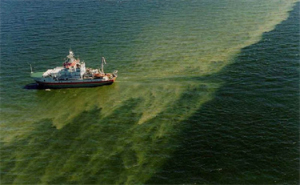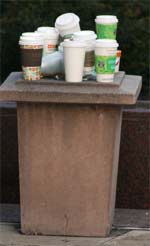What enters a watershed?
 As we saw earlier, every drop of rain that lands within the Chesapeake Bay Watershed ultimately flows toward the Bay. (Of course, some of it may not get as far as the Bay – it could get evaporated, or pulled out of a river to be used for an industrial process, or pumped into a swimming pool, but in principle it flows towards the Bay).
As we saw earlier, every drop of rain that lands within the Chesapeake Bay Watershed ultimately flows toward the Bay. (Of course, some of it may not get as far as the Bay – it could get evaporated, or pulled out of a river to be used for an industrial process, or pumped into a swimming pool, but in principle it flows towards the Bay).
But a lot of other things get washed into the Bay with that rain. Trash, for example. Salt and sand from road treatment in the winter.  Oil that drips from cars. Dirt, sand, and silt from construction sites. Those things are easy to see, but others are not.
Oil that drips from cars. Dirt, sand, and silt from construction sites. Those things are easy to see, but others are not.
When farmers fertilize their fields or spray pesticides to kill weeds or insects, large amounts of those substances wash off and end up in the water. But its not just farmers – homeowners do the same things, and so do golf courses and landscaping firms. Pesticides that kill plants or animals on the land will do the same thing in the water. But what about fertilizer, why is that a problem?
 Fertilizer is essentially food for plants – and just like too much food makes a person overweight, too much fertilizer can put a natural system out of balance. So when fertilizer enters the Bay, algae grows, sometimes in huge clouds or blooms. Sometimes the algae itself is harmful, but usually the harm occurs when the algae dies. All that dead algae causes decomposing bacteria to have a population boom, and the bacteria use up all the oxygen in the water.
Fertilizer is essentially food for plants – and just like too much food makes a person overweight, too much fertilizer can put a natural system out of balance. So when fertilizer enters the Bay, algae grows, sometimes in huge clouds or blooms. Sometimes the algae itself is harmful, but usually the harm occurs when the algae dies. All that dead algae causes decomposing bacteria to have a population boom, and the bacteria use up all the oxygen in the water.
 Basically the streams act as a huge sewer system, collecting everything discarded or washed away within the watershed. Even pharmaceuticals end up in the stream. In many urban streams, there is a detectable level of birth control drug, a morning pulse of caffeine, and a fingerprint of illegal drugs in the water.
Basically the streams act as a huge sewer system, collecting everything discarded or washed away within the watershed. Even pharmaceuticals end up in the stream. In many urban streams, there is a detectable level of birth control drug, a morning pulse of caffeine, and a fingerprint of illegal drugs in the water.
Copyright University of Maryland, 2007
You may link to this site for educational purposes.
Please do not copy without permission
requests/questions/feedback email: mathbench@umd.edu